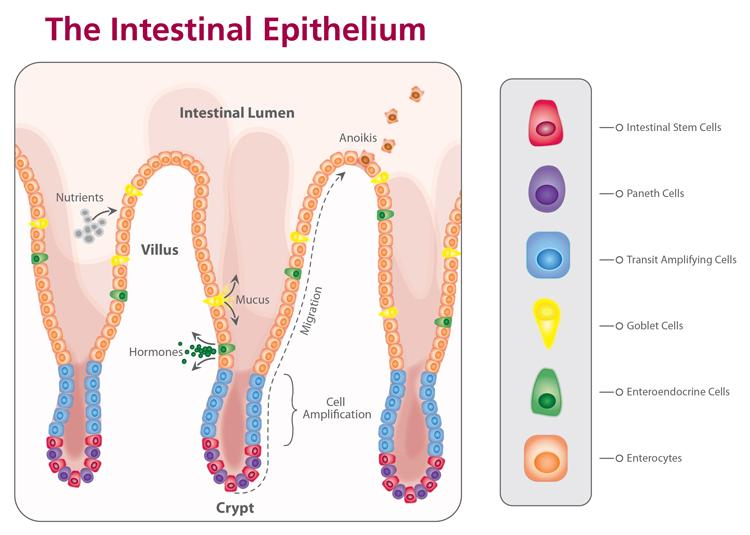
Crypts of Lieberkuhn are present in
A. Stomach
B. Colon of the large intestine
C. Ileum part of the small intestine
D. Duodenum
Answer
558.3k+ views
Hint: Villi are the small projections extending from the walls of the small intestine, which has the function of increasing the surface area for absorption. When the epithelia of the villi extend down to the lamina propria part of the small intestine wall, it forms the Crypts of Lieberkuhn. And many of the vital cells are lodged inside these crypts.
Complete answer: The ileum is the final portion of the small intestine. The wall of the ileum is made up of many tiny finger-like projections called villi and the Crypts of Lieberkuhn are present in the base of villi. This increases the surface area for the absorption of the digested nutrients. It aids in the absorption of bile salts, vitamins, and other materials that are not absorbed by the other parts of the intestine. The chemicals and enzymes responsible for the absorption of these materials are secreted by the cells located in the crypts.

Considering the other options given above:
-Stomach: The depressions called crypts are absent in the walls of the stomach. But there are infoldings present in the gastric or the stomach mucosal layer. These infoldings are known as rugae, and these increase the area for absorption.
-Colon of the large intestine: The large intestinal mucosa does not possess any infolding in the colon region. However rectum possesses these structures, but they are not villi.
-Duodenum: It is the initial part of the small intestine. It is the shortest part of the organ. And it does not possess villi or the crypts
Thus from the above options given, the most appropriate one is C, crypts of lieberkuhn are present in the mucosa of the ileum part of the small intestine.
Note: The part of the digestive system where the major part of digestion takes place in the small intestine. It is the organ where the maximum absorption of nutrients happens. The walls of the small intestine are made of four layers, which are serosa which is the outermost layer followed by muscularis, submucosa, and the innermost mucosal layer.
Complete answer: The ileum is the final portion of the small intestine. The wall of the ileum is made up of many tiny finger-like projections called villi and the Crypts of Lieberkuhn are present in the base of villi. This increases the surface area for the absorption of the digested nutrients. It aids in the absorption of bile salts, vitamins, and other materials that are not absorbed by the other parts of the intestine. The chemicals and enzymes responsible for the absorption of these materials are secreted by the cells located in the crypts.

Considering the other options given above:
-Stomach: The depressions called crypts are absent in the walls of the stomach. But there are infoldings present in the gastric or the stomach mucosal layer. These infoldings are known as rugae, and these increase the area for absorption.
-Colon of the large intestine: The large intestinal mucosa does not possess any infolding in the colon region. However rectum possesses these structures, but they are not villi.
-Duodenum: It is the initial part of the small intestine. It is the shortest part of the organ. And it does not possess villi or the crypts
Thus from the above options given, the most appropriate one is C, crypts of lieberkuhn are present in the mucosa of the ileum part of the small intestine.
Note: The part of the digestive system where the major part of digestion takes place in the small intestine. It is the organ where the maximum absorption of nutrients happens. The walls of the small intestine are made of four layers, which are serosa which is the outermost layer followed by muscularis, submucosa, and the innermost mucosal layer.
Recently Updated Pages
Master Class 12 Business Studies: Engaging Questions & Answers for Success

Master Class 12 Economics: Engaging Questions & Answers for Success

Master Class 12 English: Engaging Questions & Answers for Success

Master Class 12 Maths: Engaging Questions & Answers for Success

Master Class 12 Social Science: Engaging Questions & Answers for Success

Master Class 12 Chemistry: Engaging Questions & Answers for Success

Trending doubts
What is meant by exothermic and endothermic reactions class 11 chemistry CBSE

Which animal has three hearts class 11 biology CBSE

10 examples of friction in our daily life

One Metric ton is equal to kg A 10000 B 1000 C 100 class 11 physics CBSE

1 Quintal is equal to a 110 kg b 10 kg c 100kg d 1000 class 11 physics CBSE

Difference Between Prokaryotic Cells and Eukaryotic Cells




